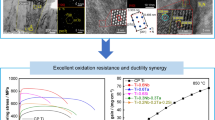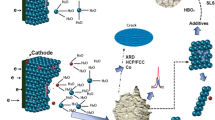Abstract
In this work, the high-temperature reduction of nickel oxide and reoxidation of metallic nickel in the YSZ–NiO anode material have been studied. As-sintered material (of mode 1) manufactured by tape casting underwent two treatment modes: one-time reduction (mode 2) in pure hydrogen for 4 h at 600 °C under a pressure of 0.15 MPa; reduction/oxidation (redox) for five cycles in hydrogen/air atmospheres at 600 °C (mode 3). The material of mode 1 exhibited a bending strength of about 209 MPa. This level is high enough for anode materials. Significant changes have been detected in the microstructure of the material reduced in hydrogen (mode 2). Agglomerates of particles (average size about 5 µm) with a predominance of the zirconium phase as well as regions of small particles (1 µm) with uniformly distributed both the nickel and zirconium phases were revealed. The intergranular fracture micromechanism prevailed in the specimens tested. The material strength (40 MPa) did not satisfy the requirements for anode materials. Despite too “rigid” redox treatment mode in pure hydrogen and air at 600 °C (mode 3), the cermet is not inferior in strength (85 MPa) to those fabricated using other techniques. On the specimen fracture surface, a porous core and dense outer layers have been revealed. An increased amount of nickel in the surface layer is probably a consequence of the microstructural transformation due to the diffusion of nickel from the subsurface region towards the surface. The redox treatment caused the specimen core degradation due to forming large pores, their coalescence into cracks, and loss of material integrity. In contrast to the mixed fracture micromechanism noted in the specimen surface layer, the intergranular one in the core was revealed. The reached level of electrical conductivity and a positive effect of the treatment on the material strength indicate the potential of the tape cast material, especially, in the case of reduction in Ar–5 vol% H2 gas mixture instead of pure hydrogen.











Similar content being viewed by others
References
ASTM F 43-99 (2005) Test methods for resistivity of semiconductor materials, CA, SEMI
Cherepova TS, Dmytrieva HP, Dukhota OI et al (2016) Properties of nickel powder alloys hardened with titanium carbide. Mater Sci 52(2):173–179. https://doi.org/10.1007/s11003-016-9940-2
Chiang L-K, Liu H-C, Shiu Y-H et al (2008) Thermo-electrochemical and thermal stress analysis for an anode-supported SOFC cell. Renew Energy 33(12):2580–2588. https://doi.org/10.1016/j.renene.2008.02.023
Chiang L-K, Liu H-C, Shiu Y-H et al (2010) Thermal stress and thermo-electrochemical analysis of a planar anode-supported solid oxide fuel cell: effects of anode porosity. J Power Sources 195(7):1895–1904. https://doi.org/10.1016/j.jpowsour.2009.10.011
Clemmer RMC, Corbin SF (2009) The influence of pore and Ni morphology on the electrical conductivity of porous Ni/YSZ composite anodes for use in solid oxide fuel cell applications. Solid State Ionics 180:721–730. https://doi.org/10.1016/j.ssi.2009.02.030
Danilenko I, Glazunov F, Konstantinova T et al (2014) Effect of Ni/NiO particles on structure and crack propagation in zirconia based composites. Adv Mater Lett 5(8):465–471. https://doi.org/10.5185/amlett.2014.amwc1040II
Danilenko I, Lasko G, Brykhanova I et al (2017) The peculiarities of structure formation and properties of zirconia-based nanocomposites with addition of Al2O3 and NiO. Nanoscale Res Lett 12:125. https://doi.org/10.1186/s11671-017-1901-7
Duriagina ZA, Kovbasyuk TM, Bespalov SA (2016) The analysis of competitive methods of improvement of operational properties of functional layers of flat heating elements. Uspehi Fiziki Metallov 17(1):29–51. https://doi.org/10.15407/ufm.17.01.029
Duryahina ZA, Kovbasyuk TM, Bespalov SA et al (2016) Micromechanical and electrophysical properties of Al2O3 nanostructured dielectric coatings on plane heating elements. Mater Sci 52(1):50–55. https://doi.org/10.1007/s11003-016-9925-1
Ettler M, Blaβ G, Menzler NH (2007) Characterization of Ni–YSZ-cermets with respect to redox stability. Fuel Cells 7(5):349–355. https://doi.org/10.1002/fuce.200700007
Ettler M, Timmermann H, Malzbender J et al (2010) Durability of Ni anodes during reoxidation cycles. J Power Sources 195(17):5452–5467. https://doi.org/10.1016/j.jpowsour.2010.03.049
Faes A, Nakajo A, Hessler-Wyser A et al (2009) Redox study of anode-supported solid oxide fuel cell. J Power Sources 193(1):55–64. https://doi.org/10.1016/j.jpowsour.2008.12.118
Fergus JW, Hui R, Li X et al (eds) (2009) Solid oxide fuel cells. Materials properties and performance. CRC Press, Boca Raton
Fischer W, Malzbender J, Blass G et al (2005) Residual stresses in planar solid oxide fuel cells. J Power Sources 150:73–77. https://doi.org/10.1016/j.jpowsour.2005.02.014
Fuel Cell Handbook, 7th ed (2004) EG&G Technical Services, Inc., U.S. Department of Energy Office of Fossil Energy National Energy Technology Laboratory, Morgantown, WV. https://www.netl.doe.gov/sites/default/files/netl-file/FCHandbook7.pdf
Jin HM, Shen MS (2009) Study of integrity of NiO oxide film by acoustic emission method. In: Proceedings of the 5th international conference on natural computation (ICNC-2009), Tianjin, China, 14–16 August 2009. https://doi.org/10.1109/ICNC.2009.133
Kharchenko Y, Blikharskyy Z, Vira V et al (2020) Study of nanostructural changes in a Ni-containing cermet material during reduction and oxidation at 600 °C. Appl Nanosci 10:4535–4543. https://doi.org/10.1007/s13204-020-01391-1
Kwak BH, Youn HK, Chung JS (2008) Ni and metal aluminate mixtures for solid oxide fuel cell anode supports. J Power Sources 185(2):633–640. https://doi.org/10.1016/j.jpowsour.2008.09.009
Larminie J, Dicks A (2003) Fuel cell systems explained, 2nd edn. Wiley, Hoboken. https://doi.org/10.1002/9781118878330
Lin C-K, Chen T-T, Chyou Y-P et al (2007) Thermal stress analysis of a planar SOFC stack. J Power Sources 164(1):238–251. https://doi.org/10.1016/j.jpowsour.2006.10.089
Lin C-K, Huang L-H, Chiang L-K et al (2009) Thermal stress analysis of planar solid oxide fuel cell stacks: effects of sealing design. J Power Sources 192(2):515–524. https://doi.org/10.1016/j.jpowsour.2009.03.010
Mori M, Yamamoto T, Itoh H et al (1998) Thermal expansion of nickel-zirconia anodes in solid oxide fuel cells during fabrication and operation. J Electrochem Soc 145(4):1374–1381. https://doi.org/10.1149/1.1838468
Ostash OP, Anofriev VH, Andreiko IM et al (2013) On the concept of selection of steels for high-strength railroad wheels. Mater Sci 48(6):697–703. https://doi.org/10.1007/s11003-013-9557-7
Ostash OP, Kulyk VV, Lenkovskiy TM et al (2018) Relationships between the fatigue crack growth resistance characteristics of a steel and the tread surface damage of railway wheel. Arch Mater Sci Eng 90(2):49–55. https://doi.org/10.5604/01.3001.0012.0662
Panteix PJ, Baco-Carles V, Tailhades P et al (2009) Elaboration of metallic compacts with high porosity for mechanical supports of SOFC. Solid State Sci 11:444–450. https://doi.org/10.1016/j.solidstatesciences.2008.09.006
Park HC, Virkar AV (2009) Bimetallic (Ni–Fe) anode-supported solid oxide fuel cells with gadolinia-doped ceria electrolyte. J Power Sources 186(1):133–137. https://doi.org/10.1016/j.jpowsour.2008.09.080
Podhurska V, Vasyliv B (2012) Influence of NiO reduction on microstructure and properties of porous Ni–ZrO2 substrates. In: Proceedings of the 3rd international conference on oxide materials for electronic engineering (OMEE-2012), Lviv, Ukraine, 3–7 September 2012. https://doi.org/10.1109/OMEE.2012.6464761
Podhurska V, Vasyliv B, Ostash O et al (2016) Influence of treatment temperature on microstructure and properties of YSZ–NiO anode materials. Nanoscale Res Lett 11:93. https://doi.org/10.1186/s11671-016-1306-z
Posuvailo VM, Kulyk VV, Duriagina ZA et al (2020) The effect of electrolyte composition on the plasma electrolyte oxidation and phase composition of oxide ceramic coatings formed on 2024 aluminium alloy. Arch Mater Sci Eng 105(2):49–55. https://doi.org/10.5604/01.3001.0014.5761
Radovic M, Lara-Curzio E (2004) Mechanical properties of tape cast nickel-based anode materials for solid oxide fuel cells before and after reduction in hydrogen. Acta Mater 52(20):5747–5756. https://doi.org/10.1016/j.actamat.2004.08.023
Ritchie RO (1999) Mechanisms of fatigue-crack propagation in ductile and brittle solids. Int J Fract 100(1):55–83. https://doi.org/10.1023/A:1018655917051
Sarantaridis D, Atkinson A (2007) Redox cycling of Ni-based solid oxide fuel cell anodes: a review. Fuel Cells 7(3):246–258. https://doi.org/10.1002/fuce.200600028
Sarruf BJM, Hong JE, Steinberger-Wilckens R et al (2018) CeO2–Co3O4–CuO anode for direct utilisation of methane or ethanol in solid oxide fuel cells. Int J Hydrogen Energy 43(12):6340–6351. https://doi.org/10.1016/j.ijhydene.2018.01.192
Serbenyuk TB, Prikhna TO, Sverdun VB et al (2018) Effect of the additive of Y2O3 on the structure formation and properties of composite materials based on AlN–SiC. J Superhard Mater 40(1):8–15. https://doi.org/10.3103/S1063457618010021
Shabri HA, Othman MHD, Mohamed MA et al (2021) Recent progress in metal-ceramic anode of solid oxide fuel cell for direct hydrocarbon fuel utilization: a review. Fuel Process Technol 212:106626. https://doi.org/10.1016/j.fuproc.2020.106626
Smirnova AL, Sadykov VA, Mezentseva NV et al (2011) Design and testing of structured catalysts for internal reforming of CH4 in intermediate temperature solid oxide fuel cells (IT SOFC). ECS Trans 35(1):2771–2780. https://doi.org/10.1149/1.3570276
Tikekar N, Armstrong T, Virkar A (2006) Reduction and reoxidation kinetics of Ni-based SOFC anodes. J Electrochem Soc 153(4):A654–A663. https://doi.org/10.1149/1.2167949
Tucker MC, Lau GY, Jacobson CP et al (2007) Performance of metal-supported SOFCs with infiltrated electrodes. J Power Sources 171(2):477–482. https://doi.org/10.1016/j.jpowsour.2007.06.076
Vasyliv BD (2009) A procedure for the investigation of mechanical and physical properties of ceramics under the conditions of biaxial bending of a disk specimen according to the ring–ring scheme. Mater Sci 45(4):571–575. https://doi.org/10.1007/s11003-010-9215-2
Vasyliv BD (2010) Improvement of the electric conductivity of the material of anode in a fuel cell by the cyclic redox thermal treatment. Mater Sci 46(2):260–264. https://doi.org/10.1007/s11003-010-9282-4
Vasyliv BD, Podhurska VY, Ostash OP et al (2018) Effect of a hydrogen sulfide-containing atmosphere on the physical and mechanical properties of solid oxide fuel cell materials. In: Nanochemistry, biotechnology, nanomaterials, and their applications. Springer proceedings in physics 214:475–485. https://doi.org/10.1007/978-3-319-92567-7_30
Vasyliv B, Podhurska V, Ostash O (2017) Preconditioning of the YSZ–NiO fuel cell anode in hydrogenous atmospheres containing water vapor. Nanoscale Res Lett 12:265. https://doi.org/10.1186/s11671-017-2038-4
Vasyliv B (2020) Improvement of the structural integrity of ceramic parts: techniques and applications. Cambridge Scholars Publishing, Newcastle Upon Tyne
Vedarsi V, Young JL, Birss VI (2010) A possible solution to the mechanical degradation of Ni-yttria stabilized zirconia anode-supported solid oxide fuel cells due to redox cycling. J Power Sources 195(17):5534–5542. https://doi.org/10.1016/j.jpowsour.2010.03.043
Waldbillig D, Wood A, Ivey DG (2005) Electrochemical and microstructural characterization of the redox tolerance of solid oxide fuel cell anodes. J Power Sources 145(2):206–215. https://doi.org/10.1016/j.jpowsour.2004.12.071
Wang Y, Walter ME, Sabolsky K et al (2006) Effects of powder sizes and reduction parameters on the strength of Ni–YSZ anodes. Solid State Ionics 177:1517–1527. https://doi.org/10.1016/j.ssi.2006.07.010
Weil KS, Koeppel BJ (2008a) Comparative finite element analysis of the stress-strain states in three different bonded solid oxide fuel cell seal designs. J Power Sources 180(1):343–353. https://doi.org/10.1016/j.jpowsour.2008.01.093
Weil KS, Koeppel BJ (2008b) Thermal stress analysis of the planar SOFC bonded compliant seal design. Int J Hydrogen Energy 33(14):3976–3990. https://doi.org/10.1016/j.ijhydene.2007.11.008
Wincewicz KC, Cooper JS (2005) Taxonomies of SOFC material and manufacturing alternatives. J Power Sources 140(2):280–296. https://doi.org/10.1016/j.jpowsour.2004.08.032
Wood A, Waldbillig D (2011) Preconditioning treatment to enhance redox tolerance of solid oxide fuel cells. US Patent 8,029,946 B2, 4 Oct 2011
Zhang T, Zhu Q, Huang WL et al (2008) Stress field and failure probability analysis for the single cell of planar solid oxide fuel cells. J Power Sources 182(2):540–545. https://doi.org/10.1016/j.jpowsour.2008.04.027
Zhang Y, Liu B, Tu B et al (2005) Redox cycling of Ni–YSZ anode investigated by TPR technique. Solid State Ionics 176:2193–2199. https://doi.org/10.1016/j.ssi.2005.06.016
Zhang Y, Liu B, Tu B et al (2009) Understanding of redox behavior of Ni–YSZ cermets. Solid State Ionics 180:1580–1586. https://doi.org/10.1016/j.ssi.2009.10.011
Zhu WZ, Deevi SC (2003) A review on the status of anode materials for solid oxide fuel cells. Mater Sci Eng A 36(1–2):228–239. https://doi.org/10.1016/S0921-5093(03)00620-8
Author information
Authors and Affiliations
Corresponding author
Ethics declarations
Conflicts of interest
On behalf of all the authors, the corresponding author states that there is no conflict of interest.
Additional information
Publisher's Note
Springer Nature remains neutral with regard to jurisdictional claims in published maps and institutional affiliations.
Rights and permissions
About this article
Cite this article
Vasyliv, B., Milewski, J., Podhurska, V. et al. Study of the degradation of a fine-grained YSZ–NiO anode material during reduction in hydrogen and reoxidation in air. Appl Nanosci 12, 965–975 (2022). https://doi.org/10.1007/s13204-021-01768-w
Received:
Accepted:
Published:
Issue Date:
DOI: https://doi.org/10.1007/s13204-021-01768-w




